Hurricane Field Program
2020 Hurricane Season
Scroll to Learn More
On this page you can find detailed descriptions of the research field activities planned for the current hurricane season. The 2020 Hurricane Field Program supports AOML’s Intensity Forecasting Experiment. This page is organized by projects that support research of the lifecycle stages of storms, from genesis to end stage.
About the Intensity Forecasting Experiment: Developed in partnership with NOAA’s Environmental Modeling Center and the National Hurricane Center, the Intensity Forecast Experiment is intended to improve our understanding and prediction of hurricane intensity change by collecting observations that will aid in the improvement of current operational hurricane models, and the development of the next-generation operational hurricane model, the Hurricane Weather Research and Forecasting model. Observations also will be collected for NESDIS’ Ocean Winds Experiment in a variety of tropical wind regimes as ‘ground truth’ for remote sensing equipment.
We are building a Weather-Ready Nation.
Supporting NOAA Operations.
With research to operational links within the HFP-IFEX Plan and through satellite validation to enhance operational utilization of satellite data within the HFP-IFEX Plan.
See How the Hurricane Field Program Supports NOAA Operations.
This document outlines the support HRD provides for operationally-tasked (EMC/NHC) NOAA hurricane aircraft missions. In the event of an operationally-tasked mission, HRD will provide support to ensure the mission achieves its goals. Click on the link below to read full documentation.
Genesis Stage
Favorable Air Mass (FAM)
Investigators
Ghassan Alaka (AOML/HRD), Jon Zawislak (AOML/HRD), Jason Dunion (AOML/HRD), Alan Brammer (CSU/CIRA), Chris Thorncroft (SUNY Albany)
Science Description
Although the ingredients for tropical cyclone formation have been well-documented for decades, it is still difficult to predict which disturbances will develop and which ones will not. A big factor in this uncertainty is the favorability of the air mass ahead of and surrounding the disturbance. This experiment proposes to collect observations of mid-level moisture and winds to assess the favorability of the air mass, which would fill in gaps in current satellite observations. These aircraft observations may also provide helpful guidance for the expanded use of satellite observations in the absence of aircraft observations.
Full Documentation
Download PDFs:
Precipitation during Formation and Observing its Response across Multiple Scales (PREFORM)
Investigators
Jon Zawislak (Co-PI), Ghassan Alaka (Co-PI), Rob Rogers (Co-PI), Jason Dunion, Paul Reasor, Mark Boothe (Naval Postgraduate School, NPS), Michael Montgomery (NPS), Tim Dunkerton (Northwest Research Associates, NWRA), Blake Rutherford (NWRA)
Science Description
An accurate prediction of tropical cyclone formation requires an improved knowledge of the precipitation (rainfall) organization and the developing storm circulation response, in the context of environmental characteristics, during the formation process. The overall goal of this experiment is to use aircraft observations to investigate how precipitation (rainfall) within a tropical disturbance is involved in the development and intensification of an incipient tropical storm circulation by sampling the characteristics of the precipitation, as well as the moisture, relative humidity, and wind structure of the circulation. It also assesses a new model for understanding how tropical storms form; a model that is colloquially referred to as the “marsupial paradigm” in which developing tropical disturbances have a closed re-circulation region that provides a favorable environment to support sustained precipitation around a preferred “sweet spot’.
Full Documentation
Download PDFs:
Early Stage
Analysis of Intensity Change Processes Experiment (AIPEX)
Investigators
Jon Zawislak, Rob Rogers, Jason Dunion, Josh Alland (NCAR), Rosimar Rios- Berrios (NCAR), George Bryan (NCAR), Falko Judt (NCAR), Michael Fischer, Jun Zhang, Paul Reasor, Joe Cione, Trey Alvey, Xiaomin Chen, Ghassan Alaka, Heather Holbach, and Josh Wadler (UM/RSMAS)
Science Description
Predicting the timing and rate of tropical cyclone strengthening events remains one of the most challenging aspects of hurricane forecasting. In their early stages, the structure of developing storms is often disorganized such that their circulations are tilted in the vertical, have prominent dry air masses that can be transported into the inner circulation, and lack rainfall coverage all around the center. These are all conditions that would otherwise be considered unfavorable for further strengthening and are often a consequence of the storm experiencing unfavorable winds in its environment. Storms with these characteristics can, however, strengthen and the goal of this experiment is to understand the physical processes and structures that govern whether storms will intensify in this type of environment.
Full Documentation
Download PDFs:
Boundary Layer
Investigators
Jun Zhang, Robert Rogers, Joe Cione, Jason Dunion, Brian Tang (U. Albany), Robert Fovell (U. Albany), George Bryan (NCAR), Rosimar Rios-Berrios (NCAR), and Falko Judt (NCAR)
Science Description
The atmospheric boundary layer is a crucial region of a tropical cyclone, because it is the area of the storm in direct contact with the ocean moisture and heat sources which power the storm. This module aims to collect observational data to improve our understanding of physical processes in the BL that control the tropical cyclone intensity change. These data can be used to evaluate the performance of tropical cyclone forecast models.
Full Documentation
Download PDFs:
Convective Burst Structure and Evolution
Investigators
Rob Rogers (PI), Jon Zawislak, Trey Alvey, Michael Bell (CSU), Anthony Didlake (PSU), Josh Wadler (UM/RSMAS)
Science Description
This module samples the vertical motion and reflectivity structure of strong thunderstorm complexes at a high frequency, e.g., every 15-20 minutes, over a 1-2 h period to observe how the structure of these systems change over time and as they move around the tropical cyclone center, along with observing how those changes affect the structure and intensity of tropical cyclones.
Full Documentation
Download PDFs:
Gravity Waves (Early)
Investigators
Jun Zhang, David Nolan (U. Miami)
Science Description
Tropical cyclone convection produces gravity waves that propagate both upward and outward. The observational data collected from this module will be analyzed to quantify the characteristics of the gravity waves in early-stage tropical cyclones and their relationship with storm intensity and intensity change. These data would also provide valuable information for model evaluation and physics improvement.
Full Documentation
Download PDFs:
Surface Wind Speed and Significant Wave Height Validation (Early)
Investigators
Heather Holbach and Ivan PopStefanija (ProSensing Inc.)
Science Description
This module will collect data in early stage tropical cyclones to continue improving surface wind speed and rain rate estimates from the Stepped-Frequency Microwave Radiometer (SFMR) when the aircraft is not flying straight and level. It will also identify the extent of 8 ft significant wave height waves. Improved measurements from the SFMR and knowledge of the surface wave field have numerous implications for forecasting and research efforts, such as providing more accurate observations to estimate tropical cyclone intensity and size along with improved estimates of marine hazards. These improvements allow for better watches and warnings for a tropical cyclone’s potential impacts to be provided to emergency managers and the general public and leads to more accurate research results.
Full Documentation
Download PDFs:
Mature Stage
Eye-Eyewall Mixing
Investigators
Sim Aberson (PI)
Science Description
Features that look like small circulations are sometimes seen in satellite images of the eyes of mature, strong tropical cyclones. However, we do not know what these features are, nor whether they have any importance to intensity change. The goal of this module is to investigate these features, especially the temperature and humidity structures, to learn what they are and how they may impact intensity.
Full Documentation
Download PDFs:
Gravity Waves (Mature)
Investigators
Jun Zhang, David Nolan (U. Miami)
Science Description
Tropical Cyclone convection produces gravity waves that propagate both upward and outward. The observational data collected from this module will be analyzed to quantify the characteristics of the gravity waves in early-stage tropical cyclones and their relationship with storm intensity and intensity change. These data would also provide valuable information for model evaluation and physics improvement.
Full Documentation
Download PDFs:
NESDIS Ocean Winds
Investigators
Paul Chang (NOAA/NESDIS/STAR), Zorana Jelenak (NOAA/NESDIS/STAR), Joe Sapp (NOAA/NESDIS/STAR)
Rainband Complex Survey
Investigators
Rob Rogers (PI), Michael Fischer, Anthony Didlake (PSU), Michael Bell (CSU)
Science Description
This module will sample the structure of long, spiral bands of rainfall (rainbands) that often extend outward from the eyewall of strong tropical cyclones out to very large distances from the center. These rainbands, often containing mixtures of strong thunderstorms and lighter rainfall that can cover huge areas, are thought to affect the structure and intensity of the tropical cyclone within which they are embedded. The data from this module will seek to explore these structures and their potential relationship with tropical cyclone structure and evolution.
Full Documentation
Download PDFs:
Research In Coordination with Operations Small Unmanned Aircraft Vehicle Experiment (RICO SUAVE)
Investigators
Joseph Cione, Jun Zhang, George Bryan (NCAR), Ron Dobosy (NOAA/ARLret), Altug Aksoy, Frank Marks, Kelly Ryan, Brittany Dahl, Josh Wadler, Josh Alland (NCAR), Rosimar Rios-Berrios (NCAR), Gijs deBoer (NOAA/PSL), Evan Kalina (NOAA/DTC), Don Lenschow (NCAR), Xiaomin Chen, Chris Rozoff (NCAR), Eric Hendricks (NCAR), Falko Judt (NCAR), Jonathan Vigh (NCAR)
Science Description
This experiment uses small drones, instead of manned aircraft, to sample the lowest and most dangerous regions of the tropical cyclone. It is believed that observations from these unique platforms will improve basic understanding and enhance forecaster situational awareness. Detailed analyses of data collected from these small drones also have the potential to improve the physics of computer models that predict changes in storm intensity.
Full Documentation
Download PDFs:
Surface Wind Speed and Significant Wave Height Validation (Mature)
Investigators
Heather Holbach and Ivan PopStefanija (ProSensing Inc.)
Science Description
This module will collect data in mature tropical cyclones to continue improving surface wind speed and rain rate estimates from the Stepped-Frequency Microwave Radiometer (SFMR) at high wind speeds and when the aircraft is not flying straight and level. It will also identify the extent of 8 ft significant wave height waves. Improved measurements from the SFMR and knowledge of the surface wave field have numerous implications for forecasting and research efforts, such as providing more accurate observations to estimate tropical cyclone intensity and size along with improved estimates of marine hazards. These improvements allow for better watches and warnings for a tropical cyclone’s potential impacts to be provided to emergency managers and the general public and leads to more accurate research results.
Full Documentation
Download PDFs:
TC Diurnal Cycle
Investigators
Jason Dunion (Co-PI), Morgan O’Neill, (Co-PI, Stanford Univ.), Daniel Chavas (Purdue Univ.), and Allison Wing (Florida State University)
Science Description
This experiment aims to collect observations that improve the understanding of how day-night fluctuations in radiation affect the intensity and structure of tropical cyclones. One component of these oscillations is a phenomenon called the tropical cyclone diurnal cycle where the cloud field of storms are seen to expand and contract each day. These daily expansions are associated with a pulse of thunderstorms and rain that travel hundreds of kilometers away from the storm center and will be observed using aircraft observations.
Full Documentation
Download PDFS:
End Stage
Tropical Cyclones at Landfall
Investigators
John Kaplan, Peter Dodge, Ghassan Alaka, Heather Holbach, Jun Zhang, Frank Marks
Science Description
Landfalling tropical cyclones can produce a variety of high impact weather conditions including damaging wind gusts and tornadoes for which there exists limited objective forecast guidance. Thus, our experiment seeks to utilize both aircraft and land-based platforms to obtain data in landfalling tropical cyclones with the overarching goal of improving both our understanding and capability to predict such dangerous phenomena that are typically associated with these landfalling systems.
Full Documentation
Download PDFs:
Satellite Validation
ADM-Aeolus
Investigators
Jason Dunion (Co-PI), Lidia Cucurull (Co-PI), Lisa Bucci (Co-PI), Mike Hardesty (Co-PI, University of Colorado – NOAA/CIRES)
Science Description
This experiment seeks to use aircraft observations to validate satellite measurements of winds in the environment of tropical cyclones. This will be accomplished by coordinating NOAA’s P-3s and G-IV high altitude jet with overpasses of the ADM-Aeolus satellite.
Full Documentation
Download PDFs:
NESDIS JPSS
Investigators
Jason Dunion (Co-PI), Jon Zawislak (Co-PI), Rebekah Esmaili (Co-PI, STC), Chris Barnet (Co-PI, NESDIS/JPSS-NASA), Michael Folmer (Co-PI, NWS/OPC), and Nadia Smith (Co-PI, STC)
Science Description
This experiment seeks to use aircraft observations to validate satellite measurements of temperature and moisture in a variety of environments that can affect tropical cyclone intensity and structure. This will be accomplished by coordinating NOAA’s GIV jet to fly below the NOAA-20 and Suomi-NPP satellites when they are passing overhead.
Full Documentation
Download PDFs:
Other Projects
Ocean Survey
Investigators
Jun Zhang, Nick Shay (U. Miami/RSMAS), Rick Lumpkin (NOAA/AOML/Physical Oceanography Division [PhOD]), Gustavo Goni (PhOD), Gregory Foltz (PhOD), Elizabeth Sanabia (USNA), Benjamin Jaimes (RSMAS), and Joshua Wadler (RMSAS)
Science Description
Physical representation of how the atmosphere and ocean interact in hurricane forecast models has not been evaluated in great detail. Observations of the ocean and the atmosphere just above the ocean surface, the energy exchanges that occur between them, and how they change over time will provide a unique opportunity to evaluate how well the models represent these lowest regions of storms. The observations that are collected should help improve how forecast models represent interactions between the ocean and atmosphere in hurricanes.
Full Documentation
Download PDFs:
Synoptic Flow
Investigators
Jason Dunion (Co-PI), Sim Aberson (Co-PI), Kelly Ryan, Jason Sippel, Ryan Torn (Univ at Albany-SUNY), Eric Blake (NWS/NHC), Mike Brennan (NWS/NHC), Chris Landsea (NWS/TAFB)
Science Description
This experiment will use advanced guidance from multiple sets of forecast models to determine locations where aircraft observations could potentially improve forecasts of tropical cyclone track, intensity and structure.
Full Documentation
Download PDFs:
Operational Flight Maps
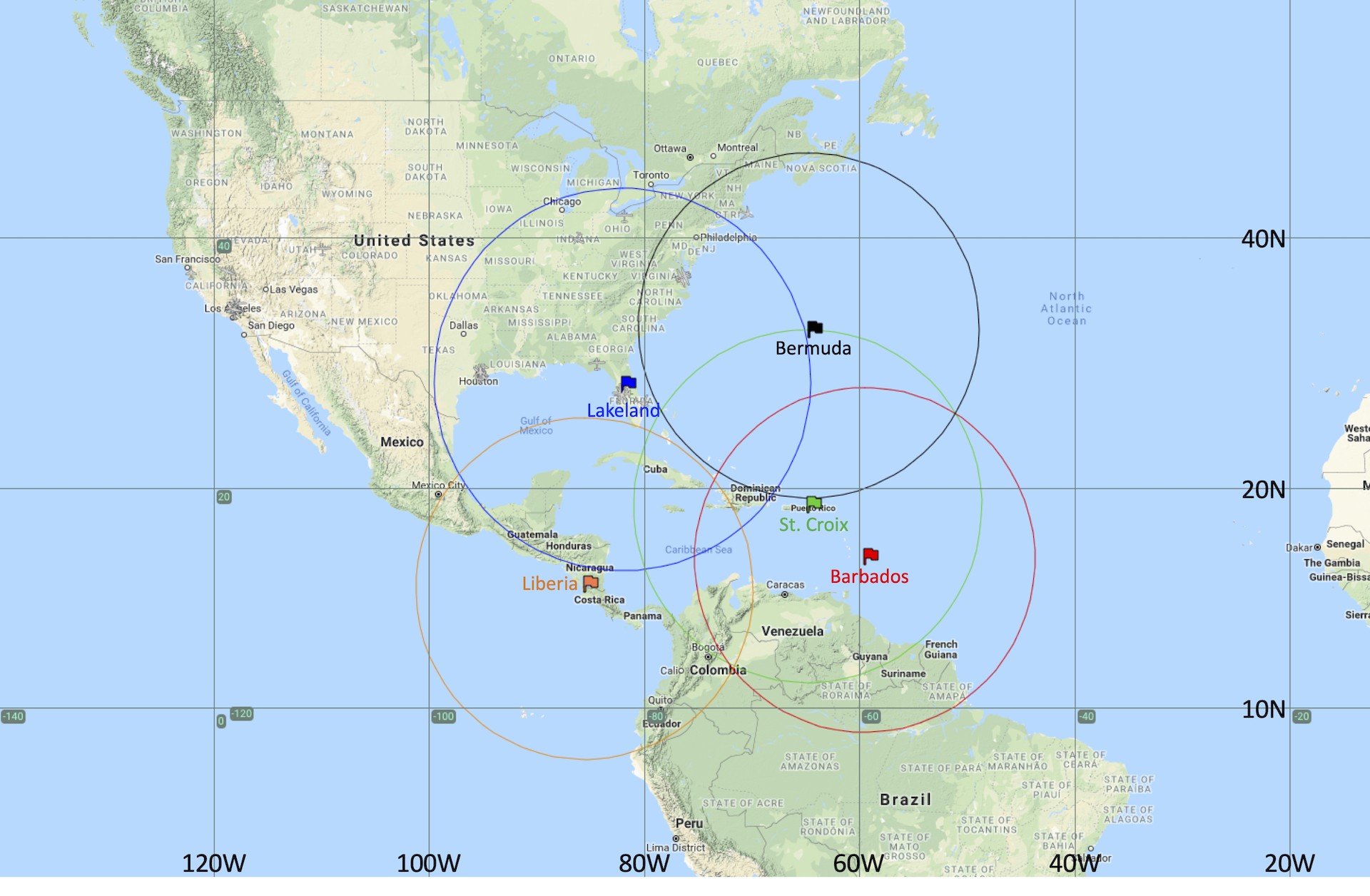
The P-3 Aircraft Operational Flight Map
Primary Atlantic operating bases and ranges (assuming ~2-h on-station time) for the P-3.
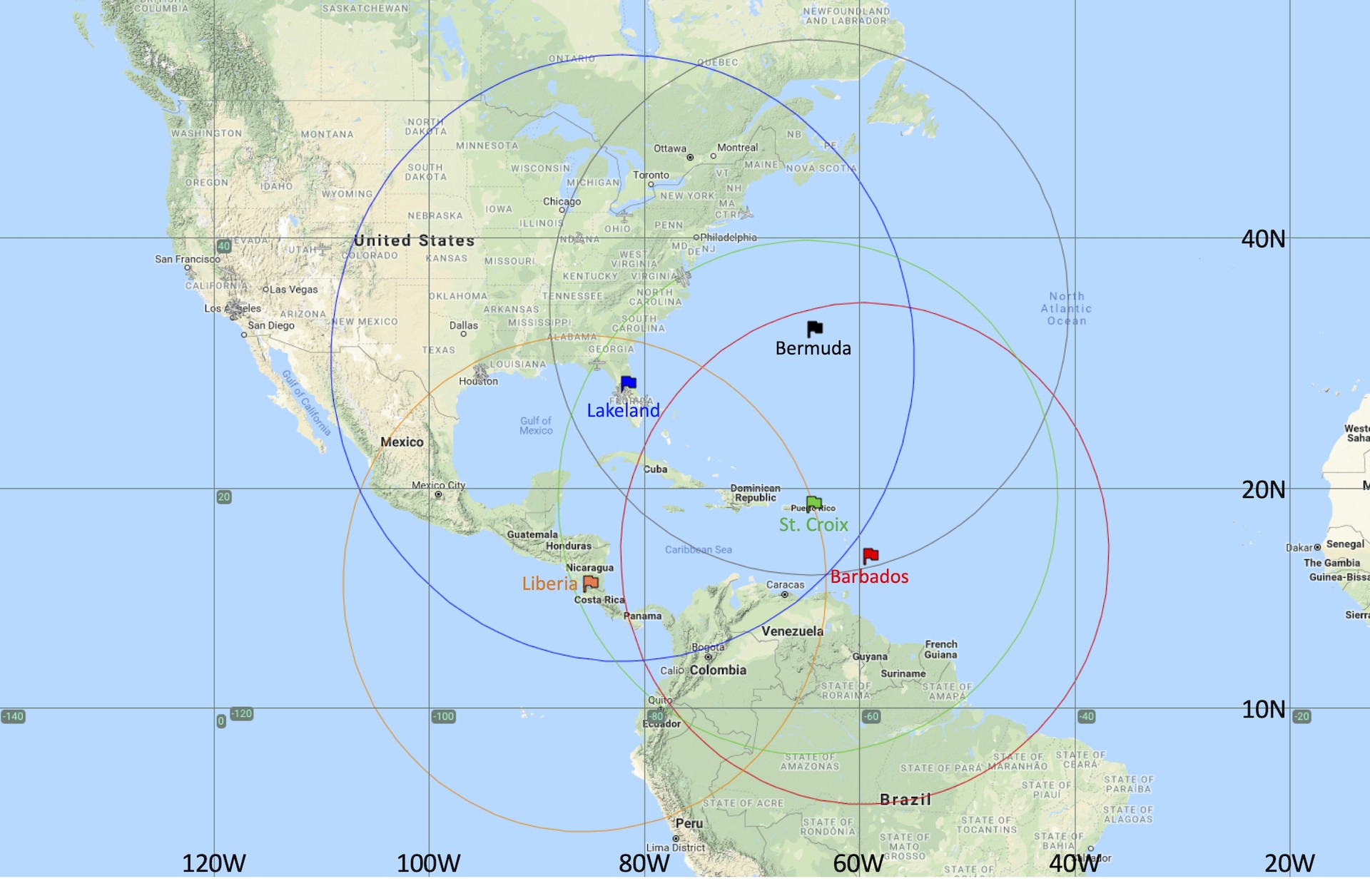
The G-IV Aircraft Operational Flight Map
Primary Atlantic operating bases and ranges (assuming ~2-h on-station time) for the G-IV.
Flight Patterns
Figure 4: P-3 & G-IV
- In-Pattern Duration: ~ 2 h 15 min (P-3), ~ 1 h 20 min (G-IV)
- Leg Lengths: 105 n mi (195 km)
- Dropsondes: centers, mid-points and turn points of each leg [10 sondes total]
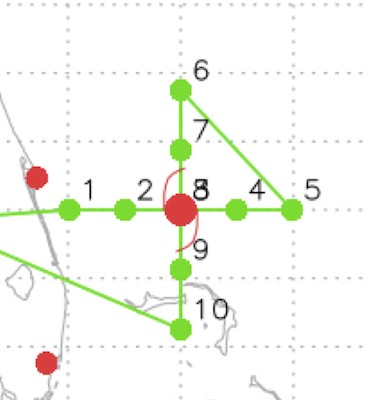
Rotated Figure 4: P-3 & G-IV
- In-Pattern Duration:~ 5 h (P-3), ~ 2 h 55 min (G-IV)
- Leg Lengths: 105 n mi (195 km)
- Dropsondes: centers, mid-points and turn points of each leg [20 sondes total]
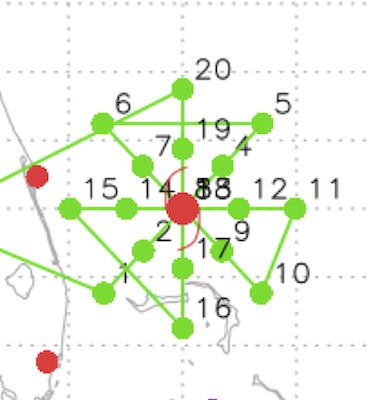
Butterfly: P-3 & G-IV
- In-Pattern Duration: ~ 3 h 25 min (P-3), ~2 h (G-IV)
- Leg Lengths: 105 n mi (195 km)
- Dropsondes: centers, mid-points and turn points of each leg [15 sondes total]
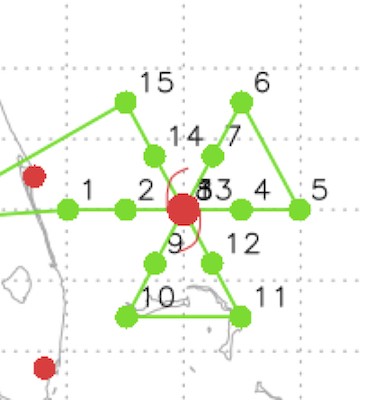
P-3 Circumnavigation
- In-Pattern Duration: ~ 4 h 5 min
- Leg Lengths (Figure-4): 105 n mi (195 km)
- Circumnavigation Radius: 50 n mi (95 km)
- Dropsondes: center of 1st pass, end points of Figure-4 and vertices of octagon [14 sondes total]
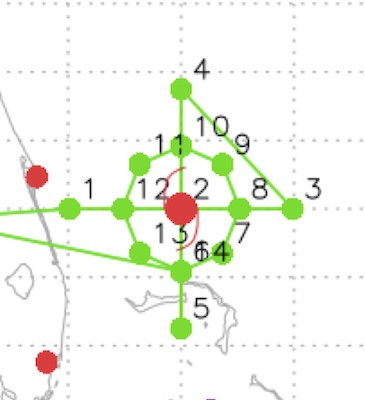
Square Spiral: P-3 & G-IV
- In-Pattern Duration: ~ 5 h 50 min (P-3), ~ 3 h 20 min (G-IV)
- Leg Lengths: 180 n mi (335 km) on a side
- Leg Increments: 0.5 deg (30 n mi)
- Dropsondes: turn points [13 sondes total]
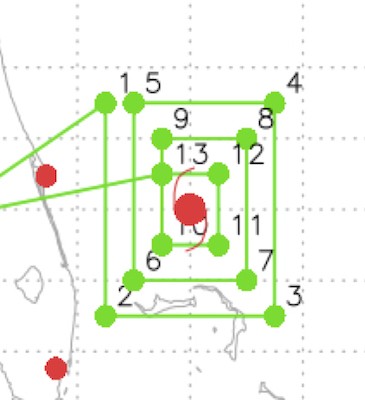
Lawnmower: P-3 & G-IV
- In-Pattern Duration: ~ 4 h 20 min (P-3), ~ 2 h 25 min (G-IV)
- Leg Lengths: 4 deg (240 n mi) x 3 deg (180 n mi) box
- Leg Increments: 1.0 deg (60 n mi)
- Dropsondes: turn points and 2 equally spaced mid-points along E-W legs [16 sondes total]
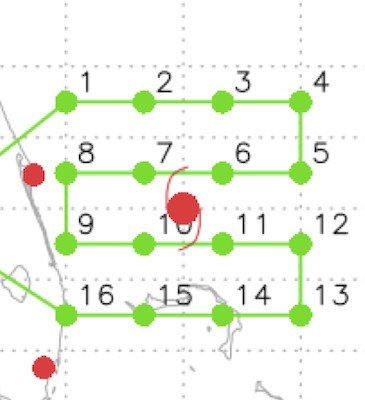
Circumnavigated Hexagon: G-IV
- In-Pattern Duration: ~ 4 h 25 min
- Circumnavigation Radii: 150, 90, 60 n mi (280, 165, 110 km)
- Dropsondes: vertices of hexagon (19 sondes total)
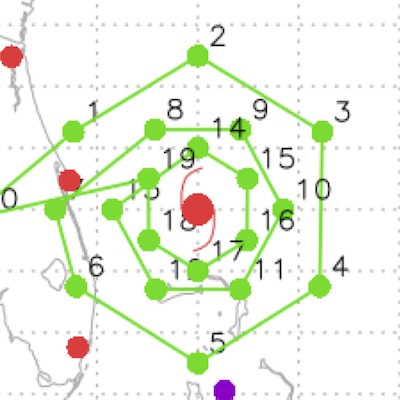
Circumnavigated Octagon: G-IV
- In-Pattern Duration: ~ 4 h 35 min
- Circumnavigation Radii: 150, 90, 60 n mi (280, 165, 110 km)
- Dropsondes: vertices of octagon (26 sondes total)
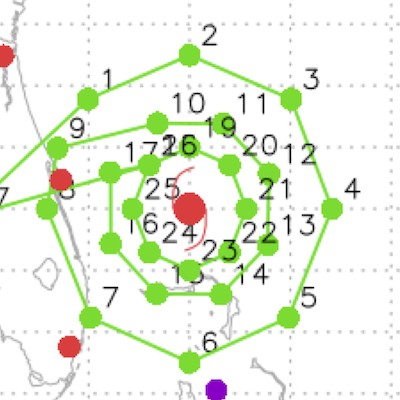
Star 1: G-IV
- In-Pattern Duration: ~ 4 h
- Inner Point Radius: 90 n mi (165 km)
- Outer Point Radius: 210 n mi (390 km)
- Dropsondes: vertices of star (13 sondes total)
- Notes: For outer points, every 0.5° adjustment inward/outward, subtracts/adds ~45 min from/to the pattern. For inner points, adjusting from 90 n mi to 60 n mi subtracts ~15 min from the pattern.
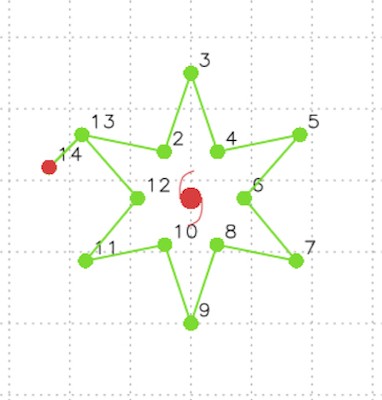
Star 2: G-IV
- In-Pattern Duration: ~ 5 h 15 min
- Inner Point Radius: 90 n mi (165 km)
- Outer Point Radius: 210 n mi (390 km)
- Circumnavigation Radius (Hexagon): 90 n mi (165 km)
- Dropsondes: vertices of star and hexagon (19 sondes total)
- Notes: For outer points, every 0.5° adjustment inward/outward, subtracts/adds ~45 min from/to the pattern. For inner points, adjusting from 90 n mi to 60 n mi subtracts ~15 min from the pattern.
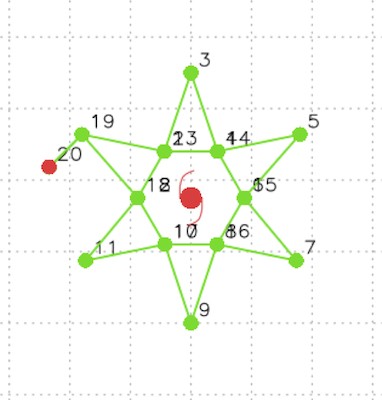
Appendices
Aircraft Information
Roles & Logistics:
Contact
| Lisa Bucci
Director, Hurricane Field Program 2020
If you would like more information on the this project, please contact Lisa Bucci, Director of the Hurricane Field Program Project for 2020.
